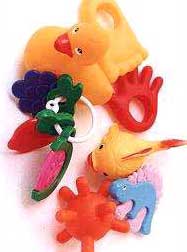 The California Center for Environmental Policy and Research announced today the results of a survey on the safety of children’s products, revealing the presence of two groups of hazardous substances: phthalates and polybrominated diphenyl ethers (PBDEs) in teething toys, plastic toys, and children’s sleepwear.
The California Center for Environmental Policy and Research announced today the results of a survey on the safety of children’s products, revealing the presence of two groups of hazardous substances: phthalates and polybrominated diphenyl ethers (PBDEs) in teething toys, plastic toys, and children’s sleepwear.
Dr. Rachel Gibson and her team investigated phthalates in 18 popular baby products and flame retardant PBDEs in 7 pieces of children’s sleepwear. The findings show:
– 15 out of 18 items, such as teething rings and bath toys, contained phthalates. For instance, a teething toy from Gund was found to contain DBP, a member of the phthalate group linked to reproductive harm and cancer.
– 3 out of 7 pieces of children’s sleepwear contained PBDEs.
Alarmingly, one product labeled “phthalate-free” was found to actually contain two phthalates: DEHP and DBP.
Phthalates are a group of chemicals used to increase flexibility in plastics and to retain fragrance in personal care products. These chemicals are associated with premature birth, reproductive system defects, and early puberty. People are exposed to phthalates through everyday use of personal and household products, as well as through inhaling polluted air and dust. The European Commission has banned the use of three types of phthalates in all products for children and three others in mouthable products for children under three years of age.
Polybrominated diphenyl ethers (PBDEs) are a group of substances used to slow down combustion. They are linked to a range of health issues, including memory impairment, cognitive decline, and weakened immune function, as well as reproductive defects and cancer.
To limit children’s exposure to these chemicals, the Center recommends:
– Avoid allowing children to put PVC plastic toys in their mouths.
– Use glass containers for children’s food and drinks.
– When cleaning plastic products, avoid using dish soap and hot water, as both can accelerate leaching.
Mỹ Linh (according to Environment California)




















































